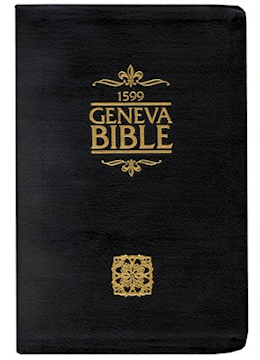Textus Receptus Bibles
Geneva Bible 1560/1599
| 3:1 | So Salomon began to buyld the house of the Lord in Ierusalem, in mount Moriah which had bene declared vnto Dauid his father, in the place that Dauid prepared in the thresshing floore of Ornan the Iebusite. |
| 3:2 | And he beganne to buylde in the seconde moneth and the second day, in the fourth yeere of his reigne. |
| 3:3 | And these are the measures, whereon Salomon grounded to buylde the house of God: the length of cubites after the first measure was threescore cubites, and the breadth twenty cubites: |
| 3:4 | And the porch, that was before the length in the front of the breadth was twentie cubits, and the height was an hundreth and twentie, and he ouerlayd it within with pure golde. |
| 3:5 | And the greater house he sieled with firre tree which he ouerlayd with good golde, and graued thereon palme trees and chaines. |
| 3:6 | And hee ouerlayde the house with precious stone for beautie: and the golde was gold of Paruaim. |
| 3:7 | The house, I say, the beames, postes, and walles thereof and the doores thereof ouerlayde he with gold, and graued Cherubims vpon the walles. |
| 3:8 | He made also the house of the most holy place: the length thereof was in the front of the breadth of the house, twenty cubits, and the breadth thereof twentie cubites: and he ouerlayde it with the best golde, of sixe hundreth talents. |
| 3:9 | And the weight of the nayles was fiftie shekels of golde, and hee ouerlayde the chambers with golde. |
| 3:10 | And in the house of the most holy place he made two Cherubims wrought like children, and ouerlayd them with golde. |
| 3:11 | And the winges of the Cherubims were twentie cubites long: the one wing was fiue cubites, reaching to the wall of the house, and the other wing fiue cubites, reaching to the wing of the other Cherub. |
| 3:12 | Likewise the wing of ye other Cherub was fiue cubites, reaching to the wall of the house, and the other wing fiue cubites ioyning to the wing of the other Cherub. |
| 3:13 | The wings of these Cherubims were spread abroade twentie cubites: they stoode on their feete, and their faces were toward the house. |
| 3:14 | He made also the vaile of blew silke and purple, and crimosin, and fine linen, and wrought Cherubims thereon. |
| 3:15 | And he made before the house two pillars of fiue and thirtie cubites hie: and the chapiter that was vpon the top of eche of them, was fiue cubites. |
| 3:16 | He made also chaines for the oracle, and put them on the heads of the pillars, and made an hundreth pomegranates, and put them among the chaines. |
| 3:17 | And he set vp the pillars before the Temple, one on the right hande and the other on the left, and called that on the right hand Iachin, and that on the left hand Boaz. |

Geneva Bible 1560/1599
The Geneva Bible is one of the most influential and historically significant translations of the Bible into English, preceding the King James translation by 51 years. It was the primary Bible of 16th century Protestantism and was the Bible used by William Shakespeare, Oliver Cromwell, John Knox, John Donne, and John Bunyan. The language of the Geneva Bible was more forceful and vigorous and because of this, most readers strongly preferred this version at the time.
The Geneva Bible was produced by a group of English scholars who, fleeing from the reign of Queen Mary, had found refuge in Switzerland. During the reign of Queen Mary, no Bibles were printed in England, the English Bible was no longer used in churches and English Bibles already in churches were removed and burned. Mary was determined to return Britain to Roman Catholicism.
The first English Protestant to die during Mary's turbulent reign was John Rogers in 1555, who had been the editor of the Matthews Bible. At this time, hundreds of Protestants left England and headed for Geneva, a city which under the leadership of Calvin, had become the intellectual and spiritual capital of European Protestants.
One of these exiles was William Whittingham, a fellow of Christ Church at Oxford University, who had been a diplomat, a courtier, was much traveled and skilled in many languages including Greek and Hebrew. He eventually succeeded John Knox as the minister of the English congregation in Geneva. Whittingham went on to publish the 1560 Geneva Bible.
This version is significant because, it came with a variety of scriptural study guides and aids, which included verse citations that allow the reader to cross-reference one verse with numerous relevant verses in the rest of the Bible, introductions to each book of the Bible that acted to summarize all of the material that each book would cover, maps, tables, woodcut illustrations, indices, as well as other included features, all of which would eventually lead to the reputation of the Geneva Bible as history's very first study Bible.